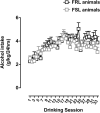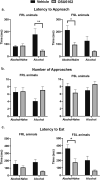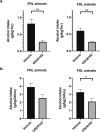The monoamine stabilizer OSU6162 has anxiolytic-like properties and reduces voluntary alcohol intake in a genetic rat model of depression
- PMID: 34088937
- PMCID: PMC8178366
- DOI: 10.1038/s41598-021-91215-1
The monoamine stabilizer OSU6162 has anxiolytic-like properties and reduces voluntary alcohol intake in a genetic rat model of depression
Abstract
Alcohol use disorders (AUD) often co-occur with anxiety and depressive disorders, and anxiety often drives relapse during alcohol abstinence. Optimal AUD pharmacotherapies may thus need to target both excessive alcohol intake and elevated anxiety. (-)-OSU6162 (OSU) is a monoamine stabilizer that attenuates alcohol-mediated behaviors in both preclinical and clinical settings. However, OSU's effect on anxiety-like behavior following long-term drinking remains unknown. To this end, we utilized a genetic rat model that exhibits increased anxiety- and depression-like behaviors (Flinders Sensitive Line; FSL) and their controls (Flinders Resistant Line; FRL). Using the novelty suppressed feeding (NSF) test, we evaluated anxiety-like behaviors (1) at baseline, (2) following long-term voluntary drinking and after 24 h of alcohol deprivation, and (3) following OSU administration in the same animals. At baseline, FSL animals displayed significantly elevated anxiety-like characteristics compared to FRL. Compared to alcohol-naïve animals, long-term drinking significantly reduced anxiety-like behaviors in FSL, without any significant effects in FRL animals. Compared to vehicle, OSU administration significantly reduced anxiety-like behaviors in alcohol-naïve FSL and long-term drinking FRL animals. While there was no significant difference in alcohol intake between FSL and FRL, OSU attenuated alcohol intake in both strains. Conclusively, in addition to the compound's previously identified ability to suppress alcohol-mediated behaviors, OSU may also possess anxiolytic properties, warranting further clinical evaluation in both AUD and anxiety disorder settings.
Conflict of interest statement
The authors declare no competing interests.
Figures






Similar articles
-
The monoamine stabilizer (-)-OSU6162 attenuates voluntary ethanol intake and ethanol-induced dopamine output in nucleus accumbens.Biol Psychiatry. 2012 Nov 15;72(10):823-31. doi: 10.1016/j.biopsych.2012.06.018. Epub 2012 Jul 18. Biol Psychiatry. 2012. PMID: 22817867
-
The monoamine stabilizer (-)-OSU6162 prevents the alcohol deprivation effect and improves motor impulsive behavior in rats.Addict Biol. 2019 May;24(3):471-484. doi: 10.1111/adb.12613. Epub 2018 Feb 26. Addict Biol. 2019. PMID: 29480646 Free PMC article.
-
Neuropeptide S alters anxiety, but not depression-like behaviour in Flinders Sensitive Line rats: a genetic animal model of depression.Int J Neuropsychopharmacol. 2012 Apr;15(3):375-87. doi: 10.1017/S1461145711000678. Epub 2011 May 9. Int J Neuropsychopharmacol. 2012. PMID: 21708052
-
Administration of antidepressants, diazepam and psychomotor stimulants further confirms the utility of Flinders Sensitive Line rats as an animal model of depression.Psychopharmacology (Berl). 1995 Sep;121(1):27-37. doi: 10.1007/BF02245589. Psychopharmacology (Berl). 1995. PMID: 8539339 Review.
-
The Fawn-Hooded (FH/Wjd) rat: a genetic animal model of comorbid depression and alcoholism.Psychiatr Genet. 2002 Mar;12(1):1-16. doi: 10.1097/00041444-200203000-00001. Psychiatr Genet. 2002. PMID: 11901354 Review.
References
-
- Stewart, S. H. & Conrod, P. J. Anxiety disorder and substance use disorder co-morbidity: Common themes and future directions. In Series in anxiety and related disorders. Anxiety and substance use disorders: The vicious cycle of comorbidity. (eds S.H. Stewart & P. J. Conrod) 239–257 (Springer, 2008). 10.1007/978-0-387-74290-8_13.
Publication types
MeSH terms
Substances
LinkOut - more resources
Full Text Sources
Medical

